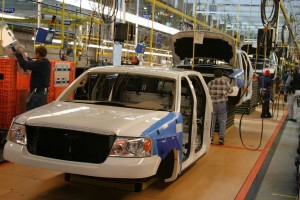
Detroit automakers spend more and get less for their money, says a new study.
Detroit’s automakers are spending more and getting less when it comes time to tool up for new products, reveals a new study. Yet, Detroit’s approach to working with its suppliers threatens to break the back of partsmakers now struggling for their survival.
On average, it costs the domestic Big Three eight percent more to create the tools that are used to produce their products – a significant portion of the cost of every new car, truck and crossover – reports the Harbour-Felax Group. And Chrysler, the least efficient of the Big Three, spends 28 percent more than the study’s leader, Honda.
The report is significant for Detroit, since it reveals another gap that the Big Three must close before being truly world-class competitors, said Laurie Harbour-Felax. But there are signs that domestic makers – General Motors, in particular – are making progress. And, in another significant finding, the study shows that Toyota, the oft-perceived industry leader, is actually losing ground due to a production system that is becoming increasingly rigid and dogmatic.
With rare exception, manufacturers use outside suppliers for their tooling and there’s a sharp difference between the way Detroit and its Japanese Big Three rivals work with their vendors, noted Harbour-Felax.
“The leaders in the industry are involving suppliers earlier in the process, taking their ideas in design and development ideas, and forming a true collaboration” she noted. “The Detroit Three, in contrast, are focused on (only) the price of components, at the end of the day. That results in an adversarial relationship. And, in today’s market, when suppliers find their backs against the wall, that doesn’t work anymore.”
In recent years, scores of automotive suppliers have been forced into bankruptcy, and in the current economic environment, analysts say that number could grow substantially. Japanese makers are more likely to help keep partsmakers out of trouble, if for no other reason than the way they pay their bills, issuing partial payment at various points along the way. Detroit makers, in contrast, make their suppliers wait until just before a new vehicle is ready to go into production, explained Harbour-Felax.
“So, with GM, Ford and Chrysler, it can be 24 months before they see a pay check,” the analyst said. “Imagine if you’re one of the big suppliers, handed a key, multi-billion dollar project and you have to fund it yourself but can no longer get credit.” A big deal with Detroit could actually break a supplier, right now, added Harbour-Felax.
Honda was the unexpected leader in the vendor tooling study, with Toyota placing second and GM third. The Detroit maker’s relatively strong performance suggests it is making strides to compete with its overseas rivals, said the analyst.
On the other hand, the study reveals that Toyota is facing some significant problems of its own. “Everyone has long believed Toyota, with its TPS (Toyota Production System) is the pinnacle,” said Harbour-Felax, “but they’ve been caught flat-footed by this economic crisis. TPS has become rigid and no longer lets them respond rapidly enough to the market.”
That, said Harbour-Felax, helps explain why the Japanese maker, now the world’s largest automotive manufacturer, is expecting to lose $4.5 billion during the fiscal year ending on March 31st.
